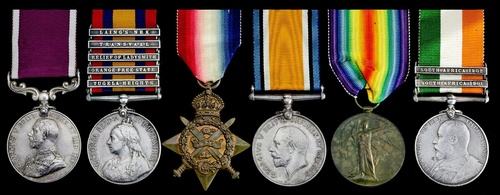
Auction: 18001 - Orders, Decorations and Medals
Lot: 299
A Great War Somme casualty's group of six awarded to Captain C. G. Tyler, Bedfordshire Regiment, late Devonshire Regiment, who was commissioned in April 1916 and killed at Trones Wood on 11 July 1916
Queen's South Africa 1899-1902, 5 clasps, Tugela Heights, Orange Free State, Relief of Ladysmith, Transvaal, Laing's Nek (4389 Sgt C. G. Tyler, Devon. Regt.); King's South Africa 1901-02, 2 clasps, South Africa 1901, South Africa 1902 (4389 Serjt. C. G. Tyler. Devon, Regt.); 1914-15 Star (4389 C. S. Mjr. C. G. Tyler, 2/Devon. R.); British War and Victory Medals (Capt. C. G. Tyler); Army L.S. & G.C., G.V.R. (4389 C. S. Mjr: C. G. Tyler, Devon. Regt.), the first two with contact marks, fine, the Great War awards rather better (6)
Cornelius George Tyler, a regular soldier and a veteran of the Boer War, arrived in France as a Company Sergeant-Major in the 2nd Battalion, Devonshire Regiment on 6 November 1914. Two days later, the Battalion was entrained for Strazeele, before marching to billets at Neuve Eglise and taking over trenches opposite Messines Ridge on the 12th. It was here that the 2nd Devons experienced their first casualties in the trenches, with three men killed and five wounded; the unit's war diary for this period also notes that 54 men were sent to hospital suffering from frostbite.
The same source notes that an 'informal armistice' took place on Christmas Day 1914: 'The Germans got out of their trenches and came towards our lines. Our men met them and they wished each other a Merry Christmas, shook hands, exchanged smokes, etc.' But sniping activity resumed around 7.30 p.m. - '1 man killed, 1 wounded.'
First Day of the Somme
Tyler was commissioned 2nd Lieutenant in the 2nd Battalion, Bedfordshire Regiment on 11 April 1916. As an experienced soldier and 'old sweat', his skills and knowledge would have been much in demand for the forthcoming Somme offensive.
At Zero Hour on 1 July 1916, the 2nd Battalion, Bedfordshire Regiment, from assembly positions near Maricourt, moved forward in the attack on Montaubin, as part of the second wave behind the 17th and 20th Battalions of the King's Liverpool Regiment. The early morning was hazy and progress was steady. The artillery bombardment had been so severe that very little resistance from rifle fire took place. Most of the casualties were sustained by shell fire. 'A' and 'D' Companies, commanded by Tyler and Captain L. F. Beal, M.C., advanced and occupied the German front line trenches, 'Faviere' and 'Silesia', whilst 'B' and 'C' Companies, commanded by Captain H. A. W. Pearce, M.C., and Captain R. O. Wynne, D.S.O., supported the advance to Dublin trench and occupied Casement trench. By nightfall, approximately 300 prisoners and four machine-guns had been taken, the men consolidating their positions via the construction of four strong points in anticipation of counter-attack.
Trones Wood
On 2 July 1916, 'A' and 'D' Companies were ordered back to the British frontline trenches under cover of darkness, to act as Divisional Reserve. At 5p.m. on 10 July, orders were received that the Battalion was to attack Trones Wood, and, if possible, entrench upon the eastern side of the wood; two battalions had earlier undertaken the same objective but both had been thrown back with heavy casualties.
That night, Tyler and his men moved up to the Sunken Road and prepared for deployment. By 1.30 a.m., the Battalion was formed up in lines of 1/2 companies, with an interval of five paces between each man, and a distance of 150 yards between platoons. 'A' Company was commanded by Tyler, 'B' by Lieutenant H. A. Chamen, 'C' by Captain L. F. Beal, M.C., and 'D' Company by Captain R. O. Wynne, D.S.O. The Battalion was ordered to enter the wood at 3.27 a.m., so the leading line started to advance at 3.10 am towards the southern edge of the wood. Once again, initial progress was good, this time under the cover of darkness, but at 400 yards range, enemy machine-guns opened up, aided by a barrage of artillery. By 3.45 a.m. the whole Battalion had entered the wood, but casualties were mounting. Owing to the dense vegetation, it was not possible to see more than four yards ahead, so the companies had great difficulty keeping in touch. It was also discovered that the wood was strongly held and fortified with a maze of trenches and dugouts.
Under Captain Tyler, the men of 'A' Company were at the head of the advance, but this resulted in heavy casualties. C. S. M. Gale was killed in action and, within this climate of confusion, Tyler discovered he was too far south of his allotted position, so had to direct his remaining 40 men north. It was shortly afterwards, at the point where Guillemont Road enters the wood, that Tyler fell severely wounded. He ordered his men to return to their trench - which they did - but owing to the ferocity of the German counter-attacks, the gallant Captain could not be brought back in and he died of his wounds. The trench was held against several counter-attacks, but at 10 p.m., the enemy surrounded and bombed the remaining men of 'A' Company from three sides. 2nd Lieutenant Laurence Hale Walker, now in command, ordered a retreat, and the remainder of the party returned to Headquarters by 11 p.m.
The son of George and Sarah Tyler, and husband of Ada Augusta Clarke (formerly Tyler) of 'Birtle Dene', Frances Avenue, Maidenhead, Berkshire, Tyler is commemorated on the Thiepval Memorial.
Subject to 20% VAT on Buyer’s Premium. For more information please view Terms and Conditions for Buyers.
Sold for
£750




